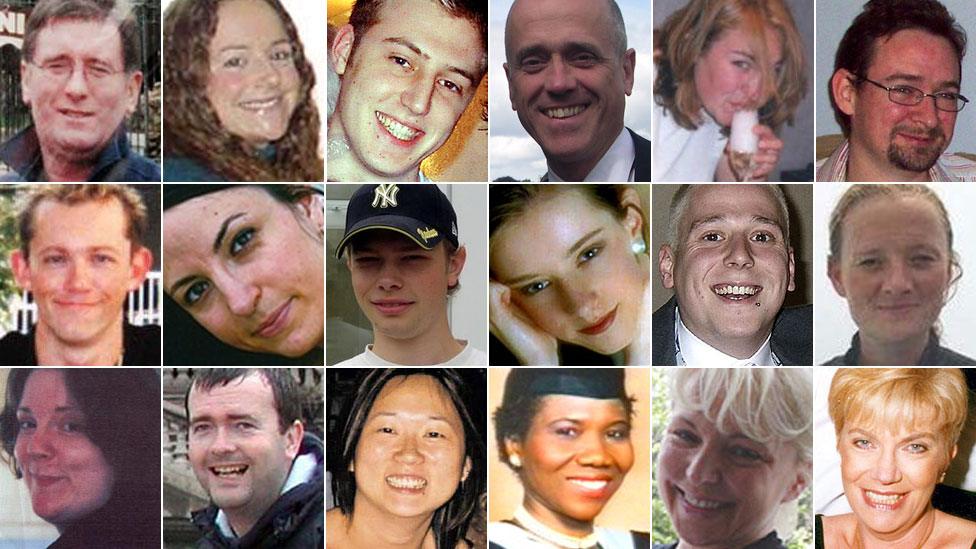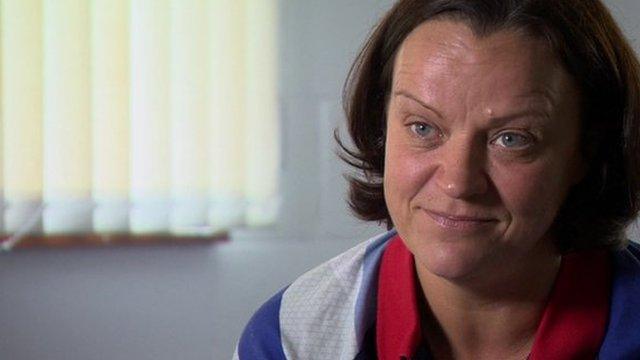7 July London bombings: What happened that day?
- Published

Ten years ago, four suicide bombers with rucksacks full of explosives attacked central London, killing 52 people and injuring hundreds more. It was the worst single terrorist atrocity on British soil. A decade on, we look back at how events unfolded on 7 July 2005.
The bombings
The bombers' journey began at 04:00 BST as three of the group - Mohammad Sidique Khan, 30, Shehzad Tanweer, 22, and 18-year-old Hasib Hussain - left Leeds, West Yorkshire, in a rented car bound for Luton, Bedfordshire. There they met their fourth accomplice, 19-year-old Germaine Lindsay, before heading to the capital by train.
They went on to detonate four devices - three on the Underground and one on a double-decker bus.

Edgware Road attack: six killed
Three of the four bombs went off just before 08:50 BST on Tube trains that had departed King's Cross.
Ringleader Mohammad Sidique Khan detonated his device on a westbound Circle Line train heading towards Paddington. The bomb exploded at Edgware Road in the second carriage close to the second set of double doors. It killed six people.
In 2011, inquests into the deaths heard that although the bomb went off at 08:50 BST, the emergency services only reached the station at 09:12.
Inquest testimony revealed the horror of the explosion's aftermath, but also tales of great bravery and survival. Daniel Biddle, who still has a 20p piece lodged in his thigh bone and has had other shrapnel, including his door keys, removed by surgeons, recalled seeing a "big, white flash".
-
Catherine Al-Wafai
×Ms Al-Wafai, who suffered small injuries to her arm and thigh, was on her way to a job interview when the blast happened, severely injuring a woman to her left. Covered in blood, Ms Al-Wafai walked away unaided from the scene. Emerging from the Tube, she found staff from a nearby Marks and Spencer store helping survivors. She only realised she had lost a shoe when she arrived home. 'I collapsed in the hallway and just curled up,' she said.
-
John Tulloch
×Professor John Tulloch was sitting on the opposite side of the carriage from Mohammed Sidique Khan. Mr Tulloch had returned from Australia a few days before the bombing and had yet to go home to Cardiff, so was carrying three bags with him. A hard suitcase by his feet saved him from serious injury. Prof Tulloch's left ear drum was perforated and shrapnel from the blast is still embedded in his head.
-
Daniel Biddle
×Daniel Biddle, running late for work, was standing close to plot ringleader Mohammad Sidique Khan when the bomb exploded. He described seeing Khan's arm move quickly and then a 'big, white flash'. The construction manager was blown from the carriage and lost both legs, his left eye and his spleen. He was helped by a fellow passenger who made tourniquets from his belt and shirt. A 20p piece remains lodged in Mr Biddle's thigh bone, and other shrapnel, including his door keys, was removed by surgeons.
-
David Gardner
×David Gardner, a management accountant at the Evening Standard, lost his left leg and spleen in the attacks. He was blown off his seat and onto the carriage floor, where he drifted in and out of consciousness while fellow passenger Jason Rennie, an ex-Army officer, made a tourniquet for his badly-damaged left leg. Mr Gardner had been due to direct a performance of Shakespeare's Julius Caesar and was reading the script when the bomb exploded.
Aldgate attack: seven killed
Shehzad Tanweer detonated his device on an eastbound Circle Line train between Liverpool Street and Aldgate. The explosion at the rear of the second carriage killed seven people.
Survivor Philip Duckworth was so close to Tanweer that he was blinded in one eye by a fragment of the bomber's shin-bone.
-
Martine Wiltshire
×Martine Wiltshire, nee Wright, who competed in the London 2012 Paralympics, was just feet away from the bomber when the device went off. She lost both legs in the blast. 'I recall a white light in front of my eyes and a feeling of being thrown from side to side,' she said. Ms Wiltshire wept as she told the inquest how she owed her life to off-duty police officer Elizabeth Kenworthy, who gave her a belt to apply as a tourniquet to stem the bleeding.
-
Andrew Brown
×Airport worker Andrew Brown, who lost a leg in the bombing, blacked out for 15 minutes after the blast. When he came round he first thought he had been electrocuted, but only realised how badly wounded he was when he tried to stand up to assist others in the train. 'As soon as I was conscious, I became aware of people moaning and calling for help,' he said.
-
Philip Duckworth
×The investment banker was so close to Shehzad Tanweer that he was blinded in one eye by a fragment of the bomber's shin-bone. Mr Duckworth described how he was thrown onto the tracks by the force of the blast and drifted in and out of consciousness. Coroner Lady Justice Hallett said his was 'an astonishing story' and that he had reduced the court to silence.
-
Bruce Lait
×The professional dancer from Ipswich was sitting reading a newspaper next to his dance partner further along the carriage from the bomber. Mr Lait suffered minor burns, cuts and burst eardrums and remains partially deaf. He told the inquest how he held the hand of victim Fiona Stevenson until she died. 'I tried to comfort her,' he said.
Russell Square attack: 26 killed
The most deadly attack occurred on the Piccadilly Line between King's Cross and Russell Square.
Germaine Lindsay detonated his bomb next to the rear set of double doors in the front carriage of the packed train, just after it pulled out of King's Cross station. Twenty-six people were killed.
Survivor Paul Glennerster described how he "picked up" his badly damaged limb and "hopped" off the bombed train.
-
Paul Mitchell
×Mr Mitchell, who was on his way to work on Regent Street, told the inquest the carriage had been crammed when 'an extremely loud pop and a very bright yellow light' went off. He was thrown to the ground by the force of the blast and recalls 'complete and utter pandemonium'. Mr Mitchell attributes his survival to fellow passenger Julie Gruen, who helped him tie a tourniquet around his damaged leg using her coat and a sanitary towel.
-
Lilian Ajayi
×Ms Ajayi was going to sit down on a seat but gave it up for another female passenger. That passenger later died. She described hearing a 'boom' and then seeing scenes of the injured piled up 'like a laundry basket'. She recalled trying to help a man, but realised his leg injury was too severe to move him. She also did not want to tell him about the extent of his injuries, she said.
-
Paul Glennerster
×Paul Glennerster told the inquest how he 'picked up' his badly damaged limb and 'hopped' off the bombed train. The keen footballer managed to get himself on to the tracks before being stretchered to the surface. He was helped by train driver Thomas Nairn, who used his belt to apply a tourniquet to Mr Glennerster's leg. Mr Glennerster was praised by the coroner for his 'amazing presence of mind'.
-
Gill Hicks
×Ms Hicks lost both legs in the blast but saved her own life by tying tourniquets to her severed limbs. She told the inquest she thought she was having a heart attack when the bomb exploded. She passed out and awoke on a seat to discover her injuries. She ripped her scarf in half and tied it around each leg before lifting what remained of them over the armrest of a seat. She was praised by the coroner for her 'indomitable spirit'.
-
Alison McCarthy
×Alison McCarthy, who joined the train at Finsbury Park, described how she passed out when the bomb went off. She woke up under injured people and bodies and her feet were embedded with glass. But she went on to help fellow passengers by applying tourniquets and keeping them conscious through conversation. 'It didn't occur to me to leave,' she said.
-
Philip Patsalos
×Prof Patsalos, who lost a leg in the blast, told the inquest he survived because he was sitting in his 'favourite' seat. He told the coroner he would have been killed if he had been sitting in his second favourite seat, which was inches from where the bomb detonated. The epilepsy specialist at University College London's Institute of Neurology said: 'How I survived, I don't know. Somebody saved me... I'm grateful.'
Tavistock Square attack: 13 killed
The youngest of the bombers, Hasib Hussain, detonated his device on a double-decker bus in Tavistock Square, not far from King's Cross. He killed 13 people.
The bombing, the fourth and final attack, took place at 09:47 BST - about an hour after the other explosions. Hussain was caught on CCTV moving in and around King's Cross station following the first three blasts. Mobile phone records showed he had tried in vain to contact his friends.
The number 30 bus was torn apart in front of the headquarters of the British Medical Association, where a conference was being held. While medical equipment was lacking, dozens of doctors offered lifesaving expertise.
The bus's driver, George Psaradakis, also recalled trying to help the injured. "Seeing my passengers in such a state really shocked me, I was overwhelmed," he said.
-
George Psaradakis
×Greek-born bus driver Mr Psaradakis had been forced to depart from his normal number 30 route on the day of the blast because of police blocking the road. He told the inquest that up to 50 people had disembarked from the bus because of the route change moments before the explosion tore through the vehicle. Mr Psaradakis described trying to help the injured. 'Seeing my passengers in such a state really shocked me, I was overwhelmed,' he said.
-
Louise Barry
×Ms Barry, who suffered injuries to her arm, leg and head, had been evacuated from the Underground at Edgware Road after one of the three earlier blasts, only to be caught in the explosion at Tavistock Square. The Australian at first thought she was having some kind of seizure, but then felt boiling water from the bus's radiator dripping on her arm. Thinking it was petrol, she described crawling through bodies to escape.
-
Camille Scott-Bradshaw
×Ms Scott-Bradshaw, on a day trip to London from Lancashire for work, lost friend and colleague Marie Hartley in the explosion. The designer, who suffered severe leg injuries and damage to her hearing, tried to find her friend in the courtyard of a nearby building. 'I just remember looking over and I think, in the corner, there were bodies... and I could see Marie... I knew it was Marie because I could see her hair, her bracelet and her arms.'
-
Lisa French
×Ms French decided not to sit next to bomber Hasib Hussain because there was not enough room for her laptop as well as his rucksack. The BT employee from Newcastle-upon-Tyne ended up sitting a few rows in front of him. She was knocked unconscious by the blast, but escaped with perforated ear drums, broken teeth, cuts and bruises. She broke down at the inquest as she described how a police officer stopped her going to help fellow passengers.

Source: All information taken from evidence provided at the 7 July inquests. All passenger positions are approximate and based on witness statements.
Produced by Lucy Rodgers, Salim Qurashi, Steven Connor
- Published3 July 2015

- Published2 July 2015

- Published30 June 2015